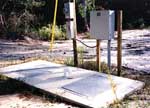In September 1997, the Hancock
County Chamber of Commerce- Environmental Committee and the
Hancock County Board of Supervisors brought together people
in the community to develop a strategic plan for the management
of wastewater in Hancock County. Chief among the participants
were staff and Board members representing the Hancock County
Wastewater District No. 1 (since renamed Hancock County Water
and Sewer District). The community initiated this effort to
find solutions to the impairment of local water bodies from
malfunctioning septic tanks and improve public health from
the threat of contamination of drinking water in private wells.
Due to the size of the lots,
the location of the lots adjacent to canals and waterways
and the types of soils, development in this area had reached
a "de facto" moratorium. Many of these lots could
not be permitted for a septic tank.
In three short years, through
community planning and consensus building, support from the
public, business and political sectors has generated more
than $15 million in grants and loans for wastewater collection
lines in Southern Hancock County. It is likely that by the
end of FY 2001, wastewater collection and treatment will be
available to all homes and businesses in Southern Hancock
County.
| Photo 1: Hancock County Mississippians
were especially proud of their first place Gulf Guardian
Award win in the Partnership Category. Here, pictured
left to right are: Bryon Griffith, Gulf of Mexico
Program Office; Ron Magee, NASA Environmental Office;
Al Smith, Wastewater District; Terry Wyly, formerly
executive director of the Hancock County Chamber of
Commerce; Lisa Cowand, Vice President of the Hancock
County Board of Supervisors; Jeep Ladner; unidentified;
unidentified; Tim Kellor, Chancery Clerk; Herman Johnson;
Steve Seymour, Supervisor. |
 |
|
|
| Photo 2: A busy Highway 90
in Bay St. Louis, Miss., is a welcome sign of economic
growth and commerce. But this same growth was causing
stress on wastewater disposal. County officials recognized
in 1997 that a plan for growth was needed. Hence was
born the Strategic Wastewater Development Plan. |
 |
|
|
| Photo 3: Old Bay St. Louis
is a picturesque community incorporating both life
on the Coast and the qualities you might expect in
a small Mississippi town. |
 |
|
|
| Photo 4: Businesses in old
town range from banks and seafood restaurants to antique
and art stores. Dock of the Bay is owned by Jerry
Fisher, former lead singer for Blood, Sweat, and Tears,
and on the second Saturday of the month you’ll
find a street festival of art, music, food and more. |
 |
|
|
| Photo 5: Businesses in old
town range from banks and seafood restaurants to antique
and art stores. Dock of the Bay is owned by Jerry
Fisher, former lead singer for Blood, Sweat, and Tears,
and on the second Saturday of the month you’ll
find a street festival of art, music, food and more. |
 |
|
|
| Photo 6: Businesses in old
town range from banks and seafood restaurants to antique
and art stores. Dock of the Bay is owned by Jerry
Fisher, former lead singer for Blood, Sweat, and Tears,
and on the second Saturday of the month you’ll
find a street festival of art, music, food and more. |
 |
|
|
| Photo 7: Businesses in old
town range from banks and seafood restaurants to antique
and art stores. Dock of the Bay is owned by Jerry
Fisher, former lead singer for Blood, Sweat, and Tears,
and on the second Saturday of the month you’ll
find a street festival of art, music, food and more. |
 |
|
|
| Photo 8: The Strategic Wastewater
Management Plan and the ensuing grants resulting from
the plan enabled the county to begin to install the
infrastructure for municipal wastewater disposal.
Prior to this plan, many of the local homes were on
private septic systems which are generally unsuitable
for coastal areas with high water tables. By 2001,
Hancock County expects to have more than 5,000 homes
sewered. |
 |
|
|
| Photo 9: The Strategic Wastewater
Management Plan and the ensuing grants resulting from
the plan enabled the county to begin to install the
infrastructure for municipal wastewater disposal.
Prior to this plan, many of the local homes were on
private septic systems which are generally unsuitable
for coastal areas with high water tables. By 2001,
Hancock County expects to have more than 5,000 homes
sewered. |
 |
|
|
| Photo 10: Hancock County
was experiencing growth as a result of Stennis Space
Center, the Port Bienville Industrial Plant, and the
introduction of gaming in the area via Casino Magic.
One of the problems was that people working in Hancock
County were having to buy or rent homes outside of
Hancock County because of the absence of a waste water
disposal infrastructure and a resulting moratorium
on new building permits. |
 |
|
|
| Photo 11: Hancock County
was experiencing growth as a result of Stennis Space
Center, the Port Bienville Industrial Plant, and the
introduction of gaming in the area via Casino Magic.
One of the problems was that people working in Hancock
County were having to buy or rent homes outside of
Hancock County because of the absence of a waste water
disposal infrastructure and a resulting moratorium
on new building permits. |
 |
|
|
| Photo 12: Hancock County
was experiencing growth as a result of Stennis Space
Center, the Port Bienville Industrial Plant, and the
introduction of gaming in the area via Casino Magic.
One of the problems was that people working in Hancock
County were having to buy or rent homes outside of
Hancock County because of the absence of a waste water
disposal infrastructure and a resulting moratorium
on new building permits. |
 |
|
|
| Photo 13: Hancock County
Port and Harbor Commissioner, Hal Walters, shows some
of the growth at Port Bienville, which includes G.E.
Plastics and Wellman. |
 |
|
|
| Photo 14: Hancock County
Port and Harbor Commissioner, Hal Walters, shows some
of the growth at Port Bienville, which includes G.E.
Plastics and Wellman. |
 |
|
|
| Photo 15: Hancock County
Port and Harbor Commissioner, Hal Walters, shows some
of the growth at Port Bienville, which includes G.E.
Plastics and Wellman. |
 |
![[logo] US EPA](../gif/logo_epaseal.gif)














